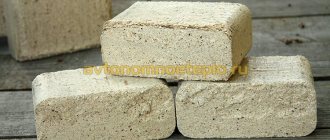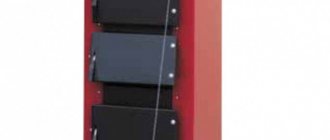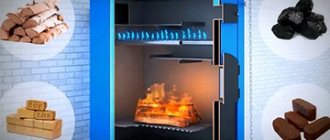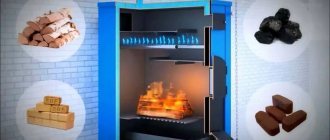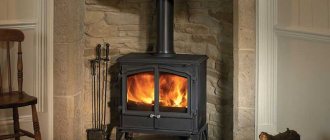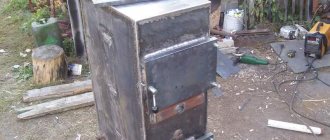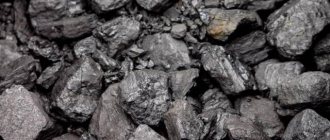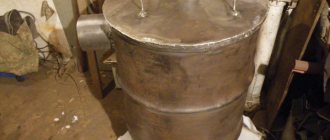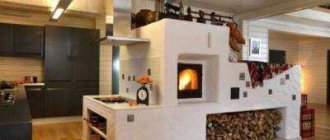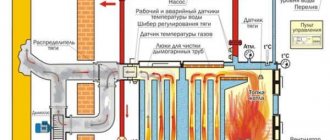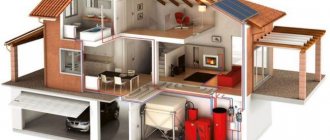The efficiency of any boiler depends on the correct ignition and combustion of fuel in it. To heat a device correctly, you need to know what features different types of fuel have and how best to light a fire in different types of devices.
In some boilers, coal, wood or pellets can burn from bottom to top, in others from top to bottom. In most long-burning devices, pellets or other fuel burns from the bottom up. These are pyrolysis and pellet devices. Some models of pyrolysis units allow you to burn pellets, wood and coal from top to bottom. This method is typical for the Stropuva and its analogues.
Preparing to light the fuel
This process is the same for all types of long-burning devices. It includes several stages:
- Cleaning the grates from ash . Move the ashes with a spatula over the grates. During this process, it falls down easily.
- Removing ash from the ash chamber . A spatula is used for this. Work carefully so as not to raise dust into the air.
- Wiping the walls of the firebox. To do this, use a dry cloth. This way they get rid of accumulated dust on the walls and future unpleasant odor that is formed when dust is burned during the burning of pellets, firewood or other types of fuel.
- Chimney cleaning. It is done very rarely. Before the first lighting of the new heating season, the chimney must be checked and cleaned.
Ignition of coal in pyrolysis boilers
If you plan to fire boilers with coal, you should always pay attention to the type of grate, because there are special modifications for each type of fuel. Many manufacturers often include coal grates in the kit.
Ignition of coal depends on whether the long-burning device has been used before and whether it has automatic controls for regulating the air supply. The main element of automation is the fan.
It is carried out like this:
- Open the scrambling door (second from the bottom) and place paper on the grate. Place thin paper or newspaper correctly.
- Special wood chips for ignition are poured onto the paper . It doesn't take much.
- Small firewood is placed on top.
- Crushed coal is placed on the firewood. Its consumption is high. The layer thickness should be 15 cm.
- The damper in the chimney is opened completely.
- They light the paper, close each door and turn on the automation, setting the required temperature level.
- After 5-10 minutes, check how the fire has flared up. To do this, turn off the automation and open the combustion door. It is better to open it slowly as the smoke output will be small. If the first portion of coal does not ignite, then close the door, turn on the automation and wait some more time. If the coal catches fire, the main portion of fuel is poured on top. Sprinkle correctly so that the cracks in the front part of the grate remain uncovered.
If a long-burning boiler is cold and has not been heated for a long time, then it is correct to light the coal using natural draft. This process is the same as igniting fuel in a long-burning device without a fan. After kindling, all doors are closed and the automatic control unit is turned on. He himself estimates the intensity of combustion, makes all the calculations and determines how much to heat the device.
Principles of kindling
Understand what fuel supply scheme is used and what the operating principle of the boiler is in general. The installation usually has 2 doors - lacing and loading. Wood chips and paper are loaded into the lacing box, and firewood is placed in the second. Then they close the door.
In many ways, the quality of operation of the installation will depend on the serviceability of the chimney system. Make sure it is warmed up and cleaned.
Ignition of coal in pyrolysis boilers using natural draft
- Open the door of the fire chamber.
- Open the ash chamber door at an angle of 45° relative to the front wall of the heating device.
- Fully open the chimney damper. Thanks to this, traction will be maximum.
- They put paper on the grates, and wood chips on the paper. They set the paper on fire.
- Small firewood is placed on a small fire. Their consumption will be small. Close the firebox door.
- When the wood has flared up, open the firebox door, fill a third of the firebox with coal and close the door.
- After all the fuel has ignited, open the firebox and add coal. They fill the firebox to the top level of the fire door. If low-quality coal is used, it may coke. This can be avoided by mixing the fuel (this is very inconvenient) or laying a layer of firewood, then a layer of coal, then firewood and coal again. In the second case, coal consumption will decrease, and firewood consumption will increase.
- The ash door is closed halfway. If, in this position, smoke comes out through the ash pan, then it needs to be covered. It cannot be completely closed.
- As soon as the coolant in the system has become warm enough, the blower is covered so that a gap of 2-5 mm remains .
- Close the throttle in the chimney halfway. This position of the throttle and the blower will contribute to the most efficient operating mode of the solid fuel device. In this mode the device should operate until 9/10 of the loaded volume of coal is burned.
- When 9/10 of the fuel has burned, you can open the blower by 5 mm. Then wait until the coal burns out or add a new one.
- Before adding coal, the throttle is opened fully . They also open the vent slightly and wait 2-3 minutes. The increased draft will pull smoke out of the combustion chamber, causing less smoke to enter the room when the firebox door is opened. Then the door is opened and coal and firewood are added. The amount of fuel is taken based on how long the boiler will be heated. The door is closed.
- The next steps depend on how much coal and firewood (other fuel) was loaded. If the loaded volume is three times greater than the volume of fuel that was in the firebox, then the vent is opened at an angle of 30-45° for 5-10 minutes . After the fuel begins to smolder, the ashtray is returned to the position at which 2-5 mm is formed. gap.
- In the case of additional loading of such a volume of coal, which is less than half of the chamber, any regulatory actions and calculations are unnecessary.
How to use solid fuel units correctly
Coal boiler operation
The operating principle of a solid fuel boiler is known, and the issue of choosing the type of coal has been resolved. All that remains is to learn how to properly light the stove. There are several simple rules that everyone who chooses the described installations for organizing heating of a country house must learn.
Remember! First, the stove must be prepared for lighting, then fuel must be correctly loaded into it. During its combustion, the installation must be closely monitored, removing combustion products in a timely manner.
Let's look at all these points in more detail.
Preparing the stove for lighting
If the stove in a country house is used occasionally, before starting its operation, for safety reasons, it is necessary to exclude the presence of cracks inside the masonry.
Why are they dangerous? Through them, combustion products and carbon monoxide can enter the room, which must be removed outside using drafts. If such a defect is discovered, it must be eliminated before kindling by covering the cracks with a mixture of clay and sand. Otherwise, when heated, the cracks may increase in size even more. And this will lead to dangerous situations.
When inspecting the stove from the outside, we remove flammable objects away from it and clean it inside. We remove the ash and slag with a shovel, freeing the internal compartment. It is advisable to wipe the inner walls of the firebox with a dry cloth. If this is not done, then during kindling the dust will begin to burn, filling the room with an unpleasant odor.
The coal stove needs to be lit several times a day. The duration of one fire should not exceed two hours. For loading, it is better to use well-dried medium-fraction coal.
Note! Wet fuel produces steam when burned. It forms condensation, which settles inside the chimney
Mixing with soot, condensate forms coke, which gradually clogs the chimney passage, narrowing it. And this leads to problems with traction.
Do not use household waste or flammable liquids such as gasoline or kerosene to ignite coal. Do not leave the stove unattended while it is burning. This rule must be observed especially strictly if there are small children or animals in the house.
How to properly melt coal?
Laying solid fuel boilers
The stove must be lit as follows:
First, we place sheets of newspaper or any other dry paper on the bottom of the firebox. On top of it we place a layer of small wood chips. And on them we stack small firewood, for example, birch logs. To make them burn faster, they need to be folded in the form of a well or a small hut. Set fire to the paper. We close the oven door and open the ash pan. Using it, it is easy to control the intensity of fuel combustion. The stronger the air flow, the faster the stack of firewood burns out. After the firewood has completely burned out and only a pile of smoldering ash remains, you need to lay a 15-centimeter layer of fine coal directly on it.
Note! When opening the door to load fuel, be sure to close the vent. When the 15-centimeter layer of coal burns well, we place larger coal directly on it and build a pillow 60 cm high
It is useful to stir the burnt fuel thoroughly beforehand, which will improve air circulation and prevent caking of the coal mass. Coal can be placed by opening the firebox door
When the 15-centimeter layer of coal burns out well, we place larger coal directly on it and build a cushion 60 cm high. It is useful to stir the burnt fuel thoroughly beforehand, which will improve air circulation and prevent caking of the coal mass. Coal can be placed by opening the firebox door.
Note! Low-quality solid fuel tends to coke. Therefore, experienced stove makers advise laying a layer of coal with layers of firewood.
Such a multi-layer cake will allow the unit to burn well and give off the maximum amount of heat.
To properly light the stove, it is better to do this - open the ash pan and let the paper with the wood chips burn out using natural circulation. This will allow the chimney to warm up well. As the fuel burns, the draft will increase, so you then need to close the ash pan and turn on the fan.
Lighting coal in the Stropuva boiler
The most common method is to pour fuel into a container, pour the flammable mixture into the duct and throw a lit match or burning wick into it. But anthracite will not ignite like that.
For it to light up you need:
- Pour in enough coal to reach the level of the bottom edge of the loading door. The consumption in this case depends on the volume of the chamber.
- Place a layer of dry small firewood on the fuel. Its thickness should be two-thirds of the height of the loading door .
- Light the wood and close the door.
- Wait until the fire burns. You can evaluate the intensity of combustion by looking through a special window made of heat-resistant glass.
- When the wood has burned down to burning coals, you need to open the door and add coal so that the top of the fuel is even with the top of the fire door.
- Fully open the air duct to obtain maximum draft.
- Wait 30-60 minutes.
- If the oven begins to heat up, close the air duct back to normal.
- The boiler must be heated in this mode until the coal is completely burned.
The question of how to properly heat a solid fuel boiler directly depends on its type. All these units operating with solid fuel can be divided into two main groups - boilers with automatic fuel supply and units with physical loading.
The first group includes the so-called pellet heating products. Their design features are more complex, and the work is almost independent; it is necessary to heat such an apparatus, maintaining a fire in it, quite rarely.
The second type of solid fuel boilers is the most common. They come in three types:
- pyrolysis;
- classic;
- long burning.
Classic devices are practically not used today, this is due to the frequent need for their maintenance, as well as the insufficient safety of the unit for consumers. But pyrolysis apparatuses and long-burning boilers are widely used and popular. This popularity is due to their correct construction and fuel efficiency.
Rice. 1 Pyrolysis solid fuel boiler
Coal
Coal is a traditional raw material for solid fuel boilers. It burns for a long time and has good heat transfer, but only if it is correctly placed in the combustion chamber, properly ignited and subsequently maintained.
Coal selection
To increase the efficiency of the boiler and extend its service life, it is necessary to take into account the manufacturer’s recommendations for choosing the grade of coal. Usually the name of the brand and its fraction are indicated in the technical data sheet of the device. Each grade has a different ratio of carbon and impurities, different humidity, structure, strength and age of formation.
The most popular types of coal for solid fuel boilers:
- Coal. The heat transfer of the fuel is 5500 kcal/kg. The average percentage of carbon and ash is 75%/3%. Suitable for igniting most classic boiler models.
- Anthracite. Specific heat indicators are 9000 kcal/hour. The percentage of carbon is no more than 7%. The disadvantage of this variety is difficulty in ignition and extremely high combustion temperature.
The most popular and convenient for ignition is long-flame coal. This universal fuel for all types of boilers ignites quickly, burns for a long time and releases a large amount of energy.
Brown coal and lingite can be found on sale. However, these varieties are recommended for use only on an industrial scale due to the large amount of ash residue and high humidity levels.
How to fire a boiler with coal
The solid fuel installation consists of two main chambers: the upper one is used to store fuel, and the lower one (ash pan) is used to collect ash and slag. As the fuel burns in the main chamber, the combustion products gradually fall into the ash pan, from where they are removed manually.
The supply of oxygen to the firebox is regulated using the ash pan damper - the draft necessary for stable combustion of the fuel is formed in the chamber.
Before starting melting, it is necessary to prepare the installation for operation. To do this, solid combustion products are removed from the ash pan, the walls of the combustion chamber are wiped and the chimney channels are cleaned.
As soon as the preparatory work is completed, you can begin loading fuel and igniting.
- Place dry paper on the grid of the main chamber. It is recommended to crumple it up first - this way it will light faster.
- Place wood chips and brushwood evenly on top in the shape of a well or hut.
- Light a match and bring it to the paper from different sides - the paper will burn evenly, involving wood chips in the process.
- Close the firebox door and open the ash pan valve to allow oxygen to enter. At this stage, you will have to monitor the combustion process of the wood chips. You can adjust the intensity using the ash pan (ash pan) door.
- As soon as the wood chips burn completely, pour a small layer of fine coal on top. Its amount should not exceed a third of the combustion chamber.
- After loading the first batch of coal, close the door again to achieve maximum combustion temperature. This usually takes about
- When the first layer of fuel completely engulfs the flame, add the remaining coal to the upper border of the door. It is recommended to stir the burning coal slightly beforehand.
- Close the blower door halfway. If there is strong smoking, leave a small crack.
More intense combustion can be ensured by closing the chimney outlet damper halfway.
As combustion proceeds, fuel is added in small portions to the main chamber, each time closing the ash pan damper. You should not put in a large amount of coal at once - this will lead to the fuel solidifying on the grate and its premature deterioration.
Features of using a solid fuel pyrolysis boiler
Regardless of what you use to heat a solid fuel boiler, the principle of its use remains the same.
Option for lighting the unit with coal:
- small wood chips and additional paper, which is required for quick ignition, are placed in the fire door;
- Larger firewood is placed in the loading door, with a small amount of coal placed on top of it;
- the paper is set on fire, you need to wait a certain time before the wood chips are ignited and you can close the door.
After these operations, the device will solve the problem of maintaining the temperature independently. The owner’s only task will be to stir the coal from time to time, since some types of coal tend to coke. If you do not want to carry out such operations, it is better to spread the fuel in layers. That is, firewood, the above-mentioned black fuel on top, the other two layers in a similar sequence.
Features of briquette firing
Now let’s take a closer look at how to properly heat a solid fuel boiler with briquettes. Kindling is performed using the same method as when using coal. It is important to consider what kind of briquettes you burn with. When using “Euro firewood”, kindling is done with wood chips and special small briquettes for ignition. If they are missing, then you can simply grind ordinary briquettes. If peat briquettes are used, kindling is done with wood chips and small firewood.
The first placement of briquettes is carried out after the formation of a stable flame and sufficient heating of the boiler. Wood briquettes (“Euro firewood”) are first laid in a layer of 10-15 cm. When it flares up well enough, a layer of briquettes 15-20 cm thick is laid. The first layer of peat briquettes should be smaller - about 5-6 cm. In the future, they are also laid in thickness 15-20 cm. The blower must be closed with each new addition of fuel. It is opened only after loading of briquettes has been completed and the combustion door has been locked. In this case, you need to install the blower in the correct position to create optimal traction.
During the combustion process, it may be necessary to stir the briquettes in the firebox. You should not do this too often, so as not to cool the firebox. Mixing must be done carefully, avoiding sudden movements, to prevent briquette dust from rising into the air and entering the room.
It is important to decide which briquettes are best to heat a solid fuel boiler. “Eurofirewood” is made from plant materials. The basis of these briquettes is dry sawdust. They may also contain husks of cereals and seeds. This type of fuel differs little in its properties from ordinary firewood, but it provides higher efficiency and burns out more slowly. During combustion, a large amount of soot is not formed. These features make wood briquettes the best option for heating a home or bathhouse.
When burning, peat briquettes emit a lot of ash, which leads to rapid contamination of the grate and ash pan, and also pollutes the room in which the boiler is installed. Therefore, this type of solid fuel is not recommended for use for heating residential buildings. The advantage of fuel briquettes is their lower price. In addition, they burn out more slowly than wood ones.
Tips for more efficient heating
If before refueling the boiler has recently been operating, and the chimney has excellent draft and has not yet lost its high temperature, it is enough to close the doors and, after turning on the control, record the desired temperature. After some time, you can remove the control unit and check whether the previously added part of the coal has ignited. If so, then it’s time to add additional combustion material. In this case, there is no need to close the slots in the front part of the grille.
Rice. 2 Automatic coal boiler
If the chimney is not preheated, after setting the paper on fire, the bottom door of the ash pan must be opened. Next, without turning on the fan, it is important to give the device some time to warm up using natural draft. After the combustion intensifies, its thrust will increase significantly; noticing this, you can close the door tightly and activate the control unit by turning it on.
When the chimney has not been used for a very long time, or it is new, it is worth warming it up well before lighting it. To do this, it is enough to set fire to the paper while inspecting the chimney until the draft in the boiler increases.
Working with a long-burning boiler
The question of how to heat a long-burning solid fuel boiler is multivariate, since the boiler can heat both by combustion and by layer. This feature allows you to significantly increase the operating time of the unit with just one load.
Loading and lighting the device is quite simple:
- Firewood is placed upward in the firebox;
- chips and paper are added through the loading door;
- the paper is set on fire, you must wait until the wood chips ignite;
- when the door is closed, you can turn on the control unit.
If all the steps have been performed correctly, the top layer will gradually begin to flare up; while the unit is operating, the entire filling will burn through from top to bottom.
In some cases, when the entire system has not fully warmed up, a small amount of barely visible condensation may appear on the walls of the heat exchanger. Sometimes this liquid can leak out of the hatches, forming small puddles on the floor. Mostly this situation is temporary. A boiler that has proper circulation will no longer produce condensation after heating the system.
Immediately after turning on the control system, it is better to leave the solid fuel device in operating mode with a high temperature. In this case, the room and the unit itself will warm up faster, after which the temperature can be reduced.
Which fuel to choose
When deciding what is the best way to heat a solid fuel boiler, it is necessary to take into account the recommendations of the equipment manufacturer. Certain boiler models can be designed for specific fuels. However, many modern units are capable of operating on all of the listed types of fuel.
When choosing how to heat a long-burning solid fuel boiler conveniently and profitably, you need to take into account the burn rate of the fuel, which can vary greatly for different types. The frequency of necessary bookmarks and the ease of use of the unit depend on this.
Dry firewood is the fuel that burns out the fastest. Therefore, today fuel briquettes, which are made from dry sawdust, are often used for TT boilers. Such briquettes, which are also called “Eurowood”, burn out 1.5-2 times slower than ordinary dry firewood. Peat fuel briquettes are also produced. However, they are characterized by high ash content, and therefore peat briquettes are used mainly for water-heating boilers with grate fireboxes. Coal burns the slowest. Some coal boilers, using high-quality anthracite and additionally equipped with a heat accumulator, are able to operate on one load for up to two days even in severe frost.
Pellets burn almost as long as coal, and at the same time provide a high level of efficiency. However, it is also the most expensive type of solid fuel for modern boilers. The main advantage of pellets is that they allow you to automate the operation of the boiler as much as possible, bringing it closer in convenience to the level of a gas unit. However, they cannot be used in a conventional TT boiler - it must be equipped with a special burner and a combustion door of a special design.
Choosing fuel for a solid fuel boiler
Many users of solid fuel boilers are very careful when choosing fuel. This is not at all surprising, since the quality operation of the unit depends on this product. Moreover, it needs to be purchased in large quantities, not only because of the cold climate, but also because the long-burning device requires refilling with large quantities of raw materials.
The following types of gas stations are considered the most popular today:
Not knowing what is the best way to heat a solid fuel boiler, you should pay attention to briquettes and pellets, which are easy to use and have a long burning time. But when using them, there is also a significant disadvantage - the high price, which is derived from the difficulty of manufacturing these products.
Firewood is no less convenient to use, but in some cases it has high humidity, which is difficult to deal with even for the newest boiler models.
But heating with coal is beneficial from all sides - its combustible effect is quite long, and during combustion it does not emit any harmful substances. The low price of the material is no less pleasing.
Hot water boiler maintenance
Check the tightness of the boiler lining once a week.
At least once a shift, check the operation of the safety valve by manually lifting the levers until water appears from the flow line.
When stopping the boiler at the end of the season, you should drain the water from the boiler, rinse, clean the boiler of dirt and scale, the flues of ash and soot, then fill the boiler and system with water, removing remaining air through the air valve. Completely clearing the combustion chamber, rotary box and grate from slag and ash.
The water heating boiler must be subject to technical inspection by the administration before being put into operation, periodically during operation (according to the established deadlines) and, if necessary, ahead of schedule.
Technical inspection of boilers must be carried out by a person responsible for the good condition and safe operation of the boiler.
External and internal inspections are aimed at:
- during the initial inspection, establish that the boiler was manufactured, installed and equipped in accordance with the “Rules for the design and safe operation of steam boilers with a steam pressure of not more than 0.07 MPa (0.7 kgf/cm2), water heating boilers and water heaters with a water heating temperature not above 388 K (115 °C)” approved by the Ministry of Construction of Russia on August 28, 1992 and the documents submitted during registration, and also that it and its elements are in good condition;
- during periodic and extraordinary inspections, establish the serviceability of the boiler and its elements and the reliability of its further safe operation.
- During external and internal inspections of the boiler and its elements, attention should be paid to identifying possible cracks, tears, bulges, bulges and corrosion on the internal and external surfaces of the walls, violations of the density and strength of welded joints, as well as damage to the lining, which can cause overheating of the metal elements boiler
Hydraulic testing of boilers is aimed at checking the strength of the boiler elements and the tightness of their connections and is carried out in the manner established by paragraphs. 3.16 and 3.17 “Rules for the design and safe operation of steam boilers with a steam pressure of no more than 0.07 MPa (0.7 kgf/cm2), hot water boilers and water heaters with a water heating temperature not higher than 388 K (115 °C)” approved by the Ministry of Construction of Russia 08/28/92
The administration is obliged to carry out inspections of boilers within the following periods:
- external and internal inspections - after each cleaning of internal surfaces or repair of boiler elements, but not less than after 12 months;
- hydraulic test with working pressure - every time after cleaning internal surfaces or repairing boiler elements;
- hydraulic test with test pressure - at least once every two years.
Early (extraordinary) technical inspection of the boiler must be carried out in cases where:
- the boiler was inactive for more than a year;
- the boiler was dismantled and installed in another place;
- bulges or dents were straightened, as well as repairs using welding of the main elements of the boiler;
- more than 50% of the total number of screen pipes were replaced at the same time;
such inspection is necessary at the discretion of the person responsible for the good condition and safe operation of the boiler.
Before hydraulic testing, external and internal inspections must be carried out.
Before internal inspection and hydraulic testing, the boiler must be cooled and thoroughly cleaned of scale, soot and ash. If there is any doubt about the good condition of the walls or seams, the person responsible for the safe operation of hot water boilers must open the lining or remove the insulation in whole or in part.
If during the technical examination of the boiler no defects are found that reduce its strength, operation of the water heating boiler is allowed under operating parameters.
If, during a technical examination of the boiler, it turns out that it has defects that cast doubt on its strength, further operation of such a boiler should be prohibited until these defects are eliminated.
The results of the inspection and the conclusion on the possibility of operating the boiler, indicating the permitted parameters (pressure, temperature) and the timing of the next inspection, must be recorded in the boiler passport by the person performing the inspection.
During an early inspection of the boiler, the reason that necessitated such an inspection is indicated.
Technical inspection of the boiler consists of external, internal inspections and hydraulic testing.
Periodic boiler cleaning
After learning how to fire a coal boiler, you need to learn how to clean it. These actions will help prolong the performance and neat appearance of the unit. During the smoldering process of coal at high temperatures, the device leaves a minimal amount of waste, which is dumped into the ash pit. The amount of waste is practically invisible; it becomes visible only after prolonged use of the device.
The entire combustion process takes place on a grate. But over time, the time comes when the solid fuel boiler needs to be cleaned. Such cleanup activities are not considered particularly time- or financially expensive.
You don’t have to worry about the best way to clean the device: any specialized store offers a large number of products used to clean soot and tar from boilers.
These products are thrown directly onto hot coals, resulting in the formation of acrid smoke, which will remove all the toxins inside the boiler and chimney. In this case, the operation of the device can not be interrupted. In addition, the walls of the device can be cleaned with a brush and a wire brush, which are usually included when purchasing the equipment.
How to properly light a boiler
How to clean soot from a coal boiler
The composition of soot includes a non-combustible residue that turns into slag during the combustion process. An additional problem is that under the influence of high temperatures, low-quality coal leads to increased formation of condensation, an acid that can corrode the metal of the heat exchanger.
Boiler cleaning is carried out in several stages:
- It is necessary to remove the ash from the ash pan, a chamber located immediately under the firebox and which is a spacious box closed with a sealed door. The ash pan is removed and the ashes are poured out.
- Cleaning of slag is carried out with a special tool, the appearance of which resembles a curved awl. Sludge is removed around the perimeter of the heat exchanger and from the grate.
In addition to regular boiler cleaning, measures are taken to prevent increased soot formation. The main reason why the heat exchanger becomes clogged with soot is insufficient combustion temperature of the fuel. Layer-by-layer stacking of firewood mixed with coal can solve the problem of increased soot formation.
How to clean the chimney pipe of a coal boiler
Proper operation of heating equipment includes measures to reduce soot formation in the chimney during boiler operation, as well as regular maintenance and cleaning of pipes. SNiP stipulates the need to carry out routine maintenance at least twice a year.
Pipe cleaning is carried out in the following ways:
Mechanical cleaning method - proper cleaning of chimneys is carried out using a special brush. Flexible plastic rods are mounted on the rod. If necessary, the brush can be extended using flexible bars that can be connected. Cleaning is carried out from the roof. Soot is removed through special inspection wells. The largest layers of soot accumulate on the bends and adapters of the chimney
During cleaning, they receive the most attention. Cleaning chemicals are available as fuel additives. It is enough to place the bag in burning coal to effectively clean the chimney
Chemicals are used as preventive measures and cannot completely replace the need for mechanical cleaning. Reducing soot emissions from coal combustion. Preventing the appearance of soot is the best measure to combat deposits on the walls of the chimney. As a preventative measure, several methods are used. A soot trap is installed, the required coal combustion temperature is ensured, the chimney design is changed and a deflector is installed to improve draft characteristics.
All of the above measures are aimed at maintaining the performance of both the boiler itself and the chimney. Acidic condensate leads to rapid burnout of the heat exchanger and chimney.
Proper operation of a coal boiler includes: proper choice of fuel, kindling and maintaining combustion in the chamber, preventing increased soot formation and regular maintenance of the heating unit and chimney.
Why is a solid fuel boiler an economical solution?
The choice of device is primarily correct for residents of dachas and cottages not connected to centralized heating. Even if such a connection is present, this unit will help to significantly save on gas bills; solid fuel is widely available and has a low price.
On the modern market you can find suitable equipment for planning a house of any complexity, even with a fairly large area. Having studied the above recommendations on how to use and maintain the boiler, these actions will take a minimum of time.
The same amount of wood can burn at different speeds and produce different amounts of heat. Next, we will tell you how you can increase the efficiency of burning wood: extend its burning time, increase heat transfer and reduce consumption without special costs.
This is the second article in a series about efficient wood burning:
Proper stacking of firewood
Typically, firewood is set on fire like this: they build a pyramid of logs, put paper and wood chips in the center and set it on fire. First, the wood chips flare up, and over time, the firewood itself. The disadvantage of this method is that you do not control the combustion. The firewood ignites all at once and entirely, burning unevenly and quickly. When some of the logs burn out, you throw in new ones, which will also quickly flare up and burn.
The burning time of firewood can be increased by changing the way it is placed in the firebox. For example:
- Lay the first bottom row of firewood.
- Place the second row on top, shifted to the right or left by 5-10cm to form a ledge. Place the third and subsequent rows on top.
- Place paper or wood chips near the edge with the ledge and set them on fire.
Laying using fuel briquettes as an example. The briquettes do not ignite entirely, but burn evenly: the flame gradually moves from left to right. A stack of firewood burns for a long time and produces a sufficient amount of heat.
- Do not place firewood close to each other. Leave a small gap between them for air movement.
- The denser and drier the wood, the more evenly it burns and the easier it is to ignite.
Close the valve in a timely manner
The stronger the draft, the faster the wood burns. But if there is not enough air, they burn poorly and form a lot of soot. Balance is important so that the minimum amount of air necessary for combustion reaches the firewood.
- Before ignition, open the heater damper to the maximum to ensure good draft for igniting the wood.
- When the wood starts to burn, begin to gradually close the valve. If the firewood starts to go out, open the valve slightly and increase the draft. Over time, you will find the optimal valve position.
The drier and denser the wood, the less air is required to burn it.
Heating a house 100 m² - 49,500 rub.
Really, honestly, really
Heating a home Detailed estimate for installation of a heating system
| Preliminary cost of equipment, materials and work for installing a heating system for a house with an area of up to 100 m² | ||
| The total cost of work and materials is: | 166500,00₽ | |
| The exact cost is determined after an engineer visits the site to inspect the facility. | ||
| Name of equipment | Qty | Price |
| Electric boiler EVAN WARMOS-M 9.45 | 1 | 19520,00₽ |
| Radiator Logatrend VK-Profil 20 500 1000 | 8 | 42560,00₽ |
| Shut-off and control valves for piping radiators | 8 | 22600,00₽ |
| Shut-off measuring and control valves for boiler piping | 1 | 6320,00₽ |
| Polypropylene pipes and fittings, fasteners. House set 100 m² | 1 | 26000,00₽ |
| TOTAL cost of materials: | 117000,00₽ | |
| Cost of installation work for this proposal: | 49500,00₽ | |
| TOTAL total cost: | 166500,00₽ |
House heating
Included by type of work
| Boiler installation | Wall or floor installation |
| Installation of pipes without “grooving” | Open pipeline installation with wall or floor mounting |
| Installation of heating radiators | Mounting the heating device on the wall, installing fasteners |
| System pressure testing | Pressure testing of the assembled system with an air compressor to identify possible leaks |
| Commissioning works | Filling with coolant (antifreeze or water), removing air from the heating system during work |
| !!! No heated floors | It is calculated additionally, it requires coordination of the type of substrate for the pipes, the type of use of the pipe, the possibility of control and automatic control, and of course the footage |
| !!! Without external chimney | To calculate the cost, an engineer’s visit is required, an inspection of the roof structure, window location and much more. |
House heating
What kind of wood is better to burn?
The heat output of the heating device and the burning time greatly depend on the type of wood.
At the molecular level, wood consists of many empty cells with walls made of woody matter. The density of this woody substance (walls) is the same for all types of wood, but the size of the cells is different.
The smaller the size of the cells, the higher the density of the wood and each square centimeter contains a lot of flammable wood matter. And vice versa: the larger the size of the cells, the lower the density of the tree. It contains a lot of air and little flammable wood matter.
Imagine that a circle is 1 square centimeter of wood. In the first case, the cells are small and there are many walls between them. In the second case, the number of cells and walls is smaller, and there are more voids filled with air. The density of such wood is low.
What conclusions can be drawn:
- Less dense wood burns quickly . When wood burns, air is released, which fuels the combustion. The more air, the firewood burns faster and less evenly.
- Dense firewood produces more heat because it contains more combustible wood matter per unit volume.
- Dense firewood leaves more coals , which take a long time to smolder. Soft woods hold their shape less well, crumble into small coals and go out quickly.
Prepare firewood in advance
Bring the wood into a warm room 2-3 days before lighting to increase its initial temperature.
The warmer the wood is initially, the:
- They spend less heat on their own heating and more on heating the room. You use heat more beneficially.
- Firewood reaches its optimal combustion mode faster, which further increases its calorific value and reduces the amount of soot emitted. This happens because the resin, creosote, tar, essential oils and other substances contained in wood do not burn at low temperatures and are deposited on the walls in the form of soot. And under optimal conditions, the combustion temperature is sufficient for them to burn entirely and release additional heat.
The difference between the combustion of “warm” and “cold” firewood is immediately noticeable: cold firewood produces a lot of smoke, which characterizes incomplete combustion. And warm, dry wood burns with virtually no smoke.
Features of wood burning
To ensure high-quality heating, you need to know how to heat a solid fuel boiler with wood efficiently and economically. For kindling, chips are laid down, on top of which you need to place 3-5 firewood with a diameter of up to 15 cm. It is recommended to lay crumpled paper between the chips so that the wood flares up faster.
After the first fire has ignited, the firebox is filled with large firewood. To achieve the most complete and efficient burning of wood, you can place 1-2 large logs in the firebox at intervals of 30-40 minutes. In addition, this method will help reduce firewood consumption.
When the firebox is completely filled with large firewood, an ordinary modern solid fuel boiler is capable of maintaining fairly intense combustion for 3-4 hours. Long-burning boilers operate on one burner even longer. It is generally not recommended to burn such models with small wood, which does not burn completely due to increased gas emission. The optimal size of logs in diameter is 15-30 cm.
If you figure out how to properly heat a TT boiler, then the choice of firewood is of great importance. Wood moisture content should not be higher than 20%, otherwise the efficiency of the equipment will be lost. In some cases, to increase the burning time, damp wood is specially placed in the firebox, which takes longer to burn. However, it must be taken into account that this leads to increased release of tar, which settles on the walls of the firebox and on the chimney, and this causes deterioration in draft. As a result, the boiler has to be cleaned more often. In order for firewood to have an optimal level of humidity, it must be dried under a canopy for approximately 1.5-2 years before use.
If you want to increase the burning time of one bookmark, then you should not use damp firewood, but set the correct position of the gate valve and thermostat. These provisions for each TT boiler model are determined experimentally.
Preheat the firebox
When wood starts to burn in a cold firebox, then:
- part of the heat is spent on heating the firebox, and not heating the room (as in the previous point).
- It is more difficult for them to flare up, since warm air overcomes the resistance of cold air in the chimney.
Basic firewood is best lit in a preheated firebox so that it does not waste extra energy heating the firebox and chimney. You can use the heat from the previous stack of firewood or pre-burn the prepared torches and paper in the firebox.
Principles of firing a brick and iron stove
Many people think that heating a stove is not such a difficult task. Heaped up some wood, set it on fire and waited until the house became warm. In fact, in order to heat the stove correctly, you need to know some features. Otherwise, you can burn a lot of wood, and the house will be cold.
Before putting firewood into the firebox, it is necessary to clean the ash chamber and grate from the remnants of previously burnt fuel. This will ensure a direct flow of air through the blower to the flame. To light the stove, it is recommended to use only dry wood. Wet or damp logs cannot be used, as this will lead to smoke and large deposits of soot in the chimney.
If you add coal, you need to select medium size. Small and too large fractions are not suitable for home ovens.
At the beginning of the heating season, the firebox needs to be thoroughly cleaned.
Place logs in the firebox. This can be done in two ways:
- hut (under a cone) if the firebox is large;
- parallel (with gaps of 8–10 cm).
Firewood should make up approximately two-thirds of the volume of the combustion chamber. There should be a free space of 15–20 cm to the top. It is better to place firewood directly in the center of the firebox or closer to the stove door, but not closer to the back wall.
Move the view to the required level. Open the ash door slightly. Using matches or thin wood chips, we set fire to a piece of birch bark or paper placed in front of the firewood.
As soon as the flame begins to engulf the wood, close the doors of both the firebox and the vent. When they begin to burn evenly, lightly cover the view.
The view allows you to regulate the combustion process
We control the fire using a view and a blower, which provide air access to the fire. Keep the combustion chamber door closed. We open it only if we need to stir the coals with a poker or add firewood.
If the stove is constantly fired with coal, when setting it up, you first need to burn a small portion of firewood and after that add a 5-6 cm layer of coal. After it flares up, add fuel up to 15 cm, then the stove will burn well and warm up evenly.
How to determine if wood is burning correctly:
- If the flame is white and noise is heard in the exhaust channels, it is necessary to close the ash door. This is an indicator of strong traction.
- If the flame has acquired a red tint and black smoke is coming out of the chimney, the draft is too low. We open the vent.
- A yellow flame means optimal combustion.
For greater efficiency, do not stir the wood until it is half burned. Only after this can they be moved with a poker. Collect burnt coals in the center of the firebox, surrounding them with burning wood and coals. In this case, it is best to close the blower door or view.
It is not recommended to constantly stir firewood
If the flame in the firebox goes out, this means that carbon monoxide has formed inside. Most likely, the firewood was wet or damp during storage. Of course, it's best not to use them. But if there are no other options, then close the firebox door and completely open the view and valve. Light the fire again and wait 10-15 minutes. During this time, carbon monoxide will disappear. Now open the door and dampers a little, and you can continue heating.
It will take 1.5–2 hours to heat the stove well. In this case, the surface heats up to 70–80°C, less often - up to 90°C. At higher temperatures, dust burns on the stove and an unpleasant odor appears. Due to overheating, cracks may form in the masonry and the device will quickly fail.
After the firewood and coal have completely burned out, the view is closed. This is necessary to maintain heat in the house until the next fire.
The process must be completed by following certain rules:
- When the wood burns out, gradually close the vent and the valve.
- After only coals remain in the firebox, you need to collect them in a heap on the grate and cover the ash pan with the view about 2/3 or 3/4.
- Only after the blue lights have completely disappeared (the process of carbon monoxide combustion), the coals can be scattered throughout the firebox and the view and door can be tightly closed.
- If for some reason it is necessary to stop the combustion process of the stove if there are unburned firebrands, you need to remove them and extinguish them yourself. It makes no sense to fill them with water. This can lead to smoke and unnecessary dampness in the combustion chamber.
In winter, it is better to heat the stove twice a day. Then the house will not cool down. The exception is the Russian stove. It can be heated only once a day, since heat transfer occurs much later.
Use bottom combustion (if possible)
There are two ways to burn wood: grate (bottom) and hearth (top burning).
Bottom burning is traditional, when air enters the firewood from below and the flame gradually moves upward. With top burning, air is supplied to the wood from above, the fire also burns at the top and gradually falls down.
With hearth burning, the largest logs are laid below, and paper and smaller firewood are placed on top.
- The completeness of combustion of wood increases, due to which they release more heat.
- You reduce the release of volatile substances that pollute the chimney with soot.
- This is a more environmentally friendly way of burning.
How to do it
For hearth burning, the firewood is stacked in a pyramid: the largest logs are placed at the bottom, and the smaller ones at the top. At the very top, wood chips and paper are set on fire.
While the wood chips and paper are burning, the firebox warms up. The flame then begins to move downwards and ignite the main wood. At this point, the combustion temperature and flame intensity are sufficient for the volatile substances that make up the wood to begin to burn. Due to the completeness of combustion, firewood releases more heat, and due to uniform combustion, it burns for a long time and economically.
Recommendations for the selection of firewood and its preparation
When selecting firewood for yourself, you need to expect that it will take some time to dry it. High humidity of fuel wood has an extremely negative effect on the operation of the heating device, and the consumption of firewood in a solid fuel boiler significantly increases.
During the combustion process, moisture accumulates on the walls of the combustion chamber, where, together with carbon monoxide, it forms tar in large quantities. After working on wet wood for just a little while, your boiler and hood will look like a pitiful sight. It will take a lot of effort to clean the combustion chamber and chimney from sticky tar. Wood heating boilers require regular cleaning. The performance of boiler equipment depends on this.
There is only one but! If this is legal firewood, then it is very expensive. In general, using oak wood for heating is a luxury. Oak is ideal as fuel for bakers.
The birch wood boiler is highly efficient. Birch burns long and brightly, releasing a large amount of thermal energy. The only drawback of birch is the large amount of resin compounds that are released during the combustion process. For residents of the middle zone, alder becomes a frequent guest in the boiler room. This tree not only burns well, but also emits a huge amount of antiseptic components.
The lowest-grade type of firewood is pine firewood. Due to the high resin content, pine logs burn intensely and emit a lot of heat. The only disadvantage of this fuel is the high speed at which pine logs turn into ash. When heating your home with pine and spruce fuel, you will certainly encounter excessive fuel consumption.
Do not allow wood to burn too high
There are three wood burning modes: low, high and optimal.
When the mode is reduced, the firewood does not burn completely and produces a lot of soot. If it is higher, you waste firewood: part of the heat flies away through the chimney, since the heat exchanger and the room do not have time to remove it completely. This occurs in two cases: you use too much wood or supply too much air. It is necessary to reduce the volume of the bookmark or draft.
The best option is when the wood burns in the optimal mode: not weakly and not strongly. The easiest way to determine the combustion mode is to use a combustion indicator, which shows the current mode in real time. If the temperature of the flue gases is more than 320 degrees, then the firewood burns at high speed.
The combustion indicator determines the flue gas temperature and combustion mode in real time
EMERGENCY STOP OF THE BOILER
6.1. If a fault is detected in one of the safety valves.
6.2. If the steam pressure has increased by 10%, exceeding the permitted pressure, and does not decrease despite the measures taken (increased water supply to the boiler, load reduction).
6.3. When the water level drops below the permissible level. Make-up is strictly prohibited, as this may lead to a boiler explosion.
6.4. When the level rises above the set point.
6.5. If all water indicating devices fail.
6.6. When they fail, all feed pumps fail.
6.7. If the main elements of the boiler (drums, collectors, screen and boiler pipes), ruptures, cracks, bulges are detected.
6.8. When the vacuum drops to less than 0.5 mm water. Art.
6.9. When one of the burners goes out.
6.10. When the water flow through the boiler is below the set value.
6.11. When the water temperature behind the boiler rises above the set value.
6.12. When the gas and air pressure increases and decreases in front of the burners.
6.13. When there is a power outage.
6.14. In the event of a fire that threatens operating personnel and the boiler.
In the event of an emergency stop of the boiler, you must:
- Stop the supply of gas and air, open the purge plug (close the valves on the burners and the valves on the gas pipeline).
- Monitor the water level in the boiler and close the main steam valve.
- Make an entry in the logbook about the reasons and time of the boiler shutdown, notify the head of the boiler room about the emergency shutdown of the boiler. In the event of a fire in the boiler room, the personnel must call the fire department and take all measures to extinguish it, without stopping monitoring the boilers.
Remove soot promptly
Soot needs to be removed not only when the chimney is clogged and there is no draft, but regularly. Soot not only impairs chimney draft, but also serves as thermal insulation. It covers the internal walls of the heating device and the heat exchanger, which reduces their heat transfer. If soot is removed in a timely manner, the volume of wood burned can be reduced without loss of heating power.
Obvious, but worth remembering: the firewood must be dry. Wet wood does not ignite well, goes out quickly and emits 2-2.5 times less heat than dry wood.
Conclusions: how to properly heat with wood
- Stack firewood carefully so that it burns evenly and for a long time.
- Close the air valve in a timely manner. The minimum amount of air required for combustion must reach the firewood.
- Dense wood burns longer and leaves more long-smoldering embers. It is best to burn with wood from hard deciduous wood: maple, walnut, birch, cherry, larch, beech, oak, sycamore, pear, apple tree
- Bring the firewood into the house 2-3 days before lighting it and place it in the firebox an hour before lighting it.
- Preheat the firebox with a small amount of splinters.
- If you have a fireplace or stove, use bottom combustion.
- Maintain optimal combustion conditions. If the wood burns too hot, some of the heat escapes into the chimney rather than remaining in the room.
- Change the volume of firewood depending on the outside temperature.
- Remove soot in a timely manner. Soot is a thermal insulator and reduces the heat transfer of the heating device and heat exchanger.
- Firewood should be as dry as possible.
Add your own ideas to the comments.
| Wood species | |
| Low density 0.15 – 0.55 g/cm 3 | Spruce, Willow, Aspen, Pine, Linden, Alder, Siberian Fir, Poplar |
| Average density 0.56 – 0.70 g/cm3 | Maple, Walnut, Birch, Cherry, Larch, Beech, Oak, Sycamore, Pear, Apple tree |
| High density 0.75 – 1.08 g/cm3 | Ash, Plum, Boxwood, Ebony persimmon, Acacia |
How to light a boiler
The most difficult thing in cycling is not to ride, but to start and finish the movement. It’s the same in the operation of a boiler - the most difficult thing is to light it. Do not expect that lighting the boiler will take you little time: you will have to allocate about an hour for this procedure.
Firing a wood-burning boiler is a responsible task
The beginning of the firebox is removing the ash and preparing the boiler for operation. After the ash pan and combustion chamber are cleaned, you can proceed to kindling.
Warming up the boiler firebox and chimney
For your own comfort and proper startup of the boiler, you need to warm up its firebox and chimney. If the heating device is not equipped with a forced smoke removal system, in order for the fuel to start burning, it is necessary to create draft. The formation of thrust is based on Archimedes' law: heated gases become lighter and tend to “float”. For their movement and removal, heating devices that burn fuel are equipped with a chimney.
Boiler diagram. Photo from the site www.viessmann.ru/
The design of the boiler is such that the path for smoke is difficult: in its path there is a heat exchanger and a complex convective surface, which reduces the speed of movement of combustion products. And the chimney pipe is usually located horizontally, which also makes it difficult for smoke to move. Therefore, if the boiler is not heated up, combustion products look for the easiest way. And most often the smoke begins to seep into the room.
In some cases, the vertical part of the chimney is equipped with a firebox (a small firebox used to warm up the chimney) with a door, by opening which you can burn a small amount of flammable fuel (for example, paper) directly in the chimney itself. When used, the heating element warms up the inside of the chimney duct.
If this possibility is not provided, then kindling is placed in the firebox - crumpled paper, birch bark - something highly flammable. On top of the kindling are chips and splinters, then logs of small thickness. The combustion chamber must be filled with firewood to no more than half the calculated volume.
At the moment of kindling, you need to open the chimney damper and the blower valve, ensuring the flow of air for combustion.
There is advice before starting the fire to open the window in the boiler room, if there is one: do not forget that the physical and chemical process of combustion requires oxygen.
How to properly heat a boiler with wood
To burn a kilogram of wood, about 5 cubic meters of air are required. If the air flow into the boiler furnace is from the boiler room, then it is necessary to arrange supply ventilation - especially if the boiler room does not have windows or they are sealed (with double-glazed windows).
After laying the logs, the kindling is ignited. When a stable combustion appears, the firebox door must be closed and the filling should be allowed to burn out.
Output to design power
As soon as the combustion chamber and chimney have warmed up sufficiently, you can proceed to the main stage of boiler operation. To do this, repeat the kindling process using well-burning materials. Now the main load of firewood is already complete, in order to fill the combustion chamber, according to the instructions for the device.
After the fuel has ignited, the boiler will reach its design capacity after some time. Now the combustion process will occur independently for some time. How long depends on the volume of the combustion chamber and the operating principle of the boiler. After the stack of firewood burns out, you will need to make a new one.
A properly functioning boiler is a source of heat and comfort in a country house
Important! When lighting, do not use lighter fluid or flammable gasoline, diesel fuel, etc.
